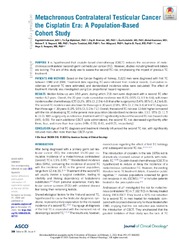Metachronous Contralateral Testicular Cancer in the Cisplatin Era: A Population-Based Cohort Study
Permanent link
https://hdl.handle.net/10037/20855Date
2020-12-23Type
Journal articleTidsskriftartikkel
Peer reviewed
Author
Hellesnes, Ragnhild; Myklebust, Tor Åge; Bremnes, Roy M.; Karlsdottir, Åsa; Kvammen, Øivind; Negaard, Helene Francisca Stigter; Tandstad, Torgrim; Wilsgaard, Tom; Fosså, Sophie Dorothea; Haugnes, Hege SagstuenAbstract
PATIENTS AND METHODS - Based on the Cancer Registry of Norway, 5,620 men were diagnosed with first TC between 1980 and 2009. Treatment data regarding TC were retrieved from medical records. Cumulative incidences of second TC were estimated, and standardized incidence ratios were calculated. The effect of treatment intensity was investigated using Cox proportional hazard regression.
RESULTS - Median follow-up was 18.0 years, during which 218 men were diagnosed with a second TC after median 6.2 years. Overall, the 20-year crude cumulative incidence was 4.0% (95% CI, 3.5 to 4.6), with lower incidence after chemotherapy (CT) (3.2%; 95% CI, 2.5 to 4.0) than after surgery only (5.4%; 95% CI, 4.2 to 6.8). The second TC incidence was also lower for those age ≥ 30 years (2.8%; 95% CI, 2.3 to 3.4) at first TC diagnosis than those age < 30 years (6.0%; 95% CI, 5.0 to 7.1). Overall, the second TC risk was 13-fold higher compared with the risk of developing TC in the general male population (standardized incidence ratio, 13.1; 95% CI, 11.5 to 15.0). With surgery only as reference, treatment with CT significantly reduced the second TC risk (hazard ratio [HR], 0.55). For each additional CBCT cycle administered, the second TC risk decreased significantly after three, four, and more than four cycles (HRs, 0.53, 0.41, and 0.21, respectively).
CONCLUSION - Age at first TC diagnosis and treatment intensity influenced the second TC risk, with significantly reduced risks after more than two CBCT cycles.


 English
English norsk
norsk